For artists, designers, architects and city planners, global warming is not a complete disaster. Suddenly the bureaucracies and politicians are willing to consider new directions in built forms. An explosion of actual possibility.
Global warming has two responses. 1. New carbonless energy sources will be harnessed to human use and the Chinese and Indians can join the middle class consumer culture. 2. All human action must be coordinated with the natural environment to slow the process of warming the planet and 90% of humans will experience new inconveniences. The first one is like the lottery. If it happens, good news for the planet and humans. But better assume not and plan for the second.
So far from the designers, we have seen the integration of planet savings devices and operation into appliances, buildings and a tiny bit of city planning. Both the high designer and eco-village builders depend on a technological assessment. High design focuses on reduced energy consumption and a perkier work or home indoor environment. Eco-village seeks a broader reduction in the use of all types of new material and celebrates the “machine” of natural processes that results in a perkier outdoor environment. High design seeks changes without lifestyle changes or much daily thought. Eco-village is an alternative lifestyle that links family-like community values with love for nature.
Two contemporary artist-designer-architects have found artistic expression of a new relationship between humans and natural processes. They move in opposite directions to find poetic integration, rather than either symbols of nature surrounding humans or delicate human acts within nature. The artists intentional blur the classic line between nature and human, but they are separate enough to caress or battle each other. Culturally and realistically, humans cannot jump to some medieval sci-fi, animated nature-man fusion (despite all the movies). While the human race changes its values, human and nature will stand apart.
Architecture and Nature: Opposite ways of integation by Singer and del Sol
In Michael Singer’s universe, nature invades the human world. Nature is a force that demands respect. Singer’s stones are placed as though the actions of erosion and plants have already modified the human construction. His instincts recall the great illustrations of ancient construction partial consumed by nature. These are named “ruins” – the human thing made dysfunctional by Nature.
Nature never retreats: Piranesi’s 1750 Rome and Catherwood’s 1840 Mexico
Singer’s cut-stone await nature: La Jolla view, Michigan levee and Denver garden
But plants are not Nature. Singer uses the plants like machines to oxygenate the air, clean the water, attract animals and enhance the human psyche. The architecture is protected from the actions of the roots and clasping vines. Rain is controlled and/or water supplied. In his larger projects, facility bi-products “feed” some other facility or action in ways that imitate natural processes.
Singer’s nature invades architecture: Labortory in Netherlands and Airport in Denver
In his best work such as the Denver Airport, nature’s dirt, her messiness and her decay symbolically threaten the illusion of man’s perfection of milled steel and glass. Not just mental symbols, but tactile contrast of wet and dry. Singer uses nature in the other direction as a symbol and producer of healthiness as in NYC Greenpoint powerplant. The greenhouse walls give a vision of overall of health and safety to the industrial activity within.
Singer’s New York Powerplant and Catherwood’s Pyramid
Art and design compete in Singer’s work. By art, I mean an intellectual and emotional jarring that Singer provides with contrast and the power of nature in the human world. By design, I mean a synthesis of functional needs and visual forms where the best solutions are comfortable. Singer’s desire to contribute to multi-disciplinary collaboration and to motivate people to do the right thing environmentally has led him to many comfortable works that are better evaluated by engineers and activists, than public art critics.
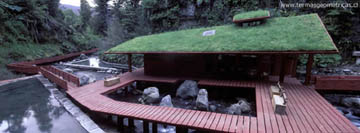
Del Sol’s Termas Geomeatas
German del Sol from Santiago, Chile, is a designer and architect that has built three eco-hotels in extreme regions of ice and desert. In reverse of Singer, del Sol intervenes into almost mythic Nature with human constructions. The work responds to human excesses of dominating the Earth by demonstrating ways to follow nature or flow with it – and still be human. Never dissolving into nature. Always celebrating raw nature through a gentle contrast of color or texture or long edges. The forms separate the earth from sky, steaming water from forest canopy, inside from out and human path from untouched nature. Both the separation and thing separating co-exist equal. In the time of saving the planet, humans can still be humans and nature, nature.
Christo’s Running Fence and Robert Smithson’s Asphalt Flow have similar requests, although the artists may have started form different purposes. Running Fence brings the curves of the landscape to life by following edges of the land through the human thing of fabric and line. Smithson pours the toxic human manufactured product down the gullies of the naturally abused canyon. Contrasting with the color of the hill and contrasting with the speed of water, the asphalt hugs the land and intensives its shapes and scares. The artistic effect of the repeated human action of dumping is one of assault and beauty. It questions and celebrates the human actions on the earth that are being performed for non-artistic reasons without a care.
Christo and Robert Smithson: Human action follows the land
Del Sol limits his sentences of making to path and fence interacting with raw nature through the animation of sunlight (harsh, luminous or wet). Paths mark the place for humans in nature while fences isolate sections of land and sky. But nothing is pure as the fences are broken and marks of nature dot the sections of land. Humans need not be pure in their relationship with nature. Neither do humans need to exaggerate through a rational contrast. The two remain separate fully influenced and engaged by the other.
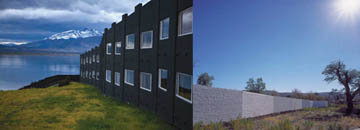
Del Sol’s gentle break between ground and sky: Patagonia Ice and Atacama Desert
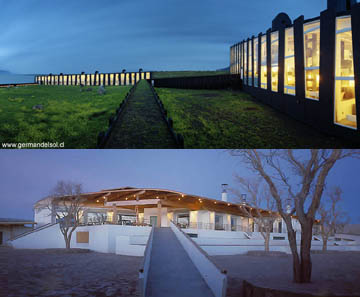
Del Sol’s captured nature: Patagonia stone and Atacama trees
In their art, both Singer and del Sol express a truth of engagement with nature. Singer brings nature to urbanity and del Sol marks nature with humanness. In this time of environmental crisis, both demonstrate a respect for nature that understands that she has the power to stand and survive. For at the end of it all, humans will die, not nature.
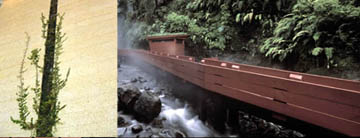
Nature and Architecture: Opposite slices by Singer and del Sol
.
Excellent Sculpture Magazine Interview with Singer.
Del Sol’s Spanish Poetry and Images
Del Sol’s photos by Guy Wemborne
.
.
.
I like these images, but could not find a place from them above.
Del Sol’s plans: Capture with ways to run away
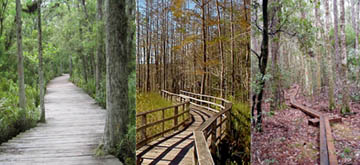
Florida Boardwalks: Fragile human access to nature
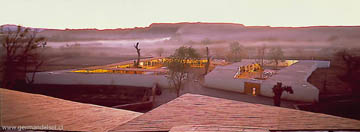
Del Sol touching lightly in the Atacama desert
Digg it…Del.icio.us …Technorati…Stumble Upon..Reddit
